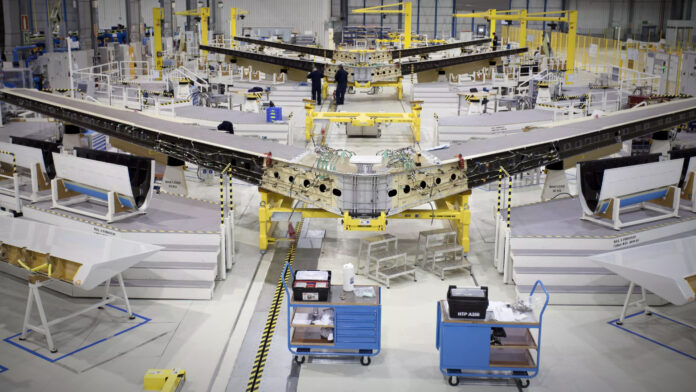More excerpts and leftovers, here, from the new RCR Wireless editorial report on private 5G in Industry 4.0 (check it out), rendered as a full Q&A with Hakim Achouri, telecoms expert and architect at European aviation and aerospace manufacturer Airbus. If you have been following the Airbus story in these pages (since 2019, at least) – about industrial IoT sensor networks, exploding into industrial 4G/5G cellular networks – then you will know what an Industry 4.0 pioneer it is. If you haven’t, then may we suggest you check out the 2019 series about its rules for Industry 4.0 (including, ‘Take your bullshit tech, and come back when it’s ready’), and the 2022 double-hander from Private Networks Forum and 5G Manufacturing Forum, hosted by RCR Wireless, about its adventures to design (‘Flight of the navigator’) and scale (‘That’s the fun part’) 5G across its international operations.
A 2023 entry from Hannover Messe, where Airbus, flanked by Volkswagen and Bosch (plus others), expresses some cautious optimism about private 5G is also worth a read. Airbus also features in a recent round-up of genuinely large-scale private 5G deployments.

This interview, which is cherry-picked for choice quotes in the new RCR Wireless report (‘Highly bespoke and easily scalable – balancing customisation and simplicity in private industrial 5G networks’), picks up on the last 2022 post about its digital-change programme, from an interview with Achouri, which reported: “Airbus is going way beyond 11 networks at 11 sites, expanding beyond its core European manufacturing bases in France and Germany, to also deploy private 5G in Canada, China, Spain, the UK, and the US. And it is doing so with a cookie-cutter blueprint, effectively – based on the principle that what works once works every time (counter to the SI narrative that every plant is different).” As below, and as written in the report, progress has possibly slowed since.
Or else, more likely, previous coverage should have been clearer, or probed further. No matter, the message from Achouri, today, is that the firm has three live networks in Europe, and retains the same plan to scale to Canada, China, the UK, and the US. The rest of the discussion is brilliant, as always with Airbus. Achouri responds candidly to questions about vendors (Ericsson is in, Orange Business is in, but RFPs are also out to tender), blueprints (the 20 in the 80/20 rule for modularity/customisation is about OT machines; see also: ‘The driller has to drill, but it also has to compute’), and targets (to put everything on 5G). Helpfully, he also tours about the challenge with IT/OT integration (discussed in detail in the report) and throws in some neat cautionary answers about URLLC and RedCap.
Enjoy; all the answers below are from Achouri.

Can you update on the private 5G rollout at Airbus? Last time, you said seven (LTE/5G) networks had been installed, with 11 networks at 11 sites scheduled in France and Germany. But you also suggested private networks will soon be deployed in Canada, China, Spain, the UK, and the US, as well. Where are you up?
“We have three sites live, in production [facilities] in Europe – in France, Germany, and Spain. We are extending to two more plants in Germany and France. The UK is planned for 2025. Proliferation and standardisation in the EU is ongoing. We are scaling up; seven thousand SIM cards have been delivered. Outside of Europe, we are in the initiation stage, awaiting launch of a first proof-of-concept (PoC) with partners in the US and Canada. In China, we already have a PoC running but we are looking to standardise it and align it with our standard architecture in the EU.”
Who are you using in terms of RAN / core network vendors? Is it all with Ericsson? Are you partnering with mobile operators at any sites? Why? Are you working with SI partners on these projects?
“All of our infrastructure is currently [from] Ericsson. We have been running an RFI for [a] new packet core for almost 18 months. The result is under review and remains confidential. Last year we ran three labs (trials) with potential new vendors, going through our requirement list. We are also running PoCs for precise geolocation with Nokia, and have also looked at this topic with ASOCS and other vendors. [In other words, we have moved beyond] an R&D topic at this stage. We work with SIs, variously; Orange Business is the incumbent [managed service provider] in charge of L1 and L2 support – but based on the Airbus design. We are always in discussions with other telcos and SIs in other geographical regions – to either build back-to-back with our existing contracts, or [to build] direct if it meets a global connectivity strategy.”
How do you rationalise customisation and scalability? Does a cookie-cutter blueprint still hold for the replication / scaling of private 5G networks? Does it remain a straightforward process from an architectural point of view?
“This is the goal, most definitely. We build standards that are cybersecurity approved. We take advantage of our automation stacks to rationalise and replicate in any other location. The goal is to automate our infrastructure in order to scale fast and [make] changes fast whilst simplifying our procurement [and] operational processes. [He makes reference to scalability with “contract and catalogue reuse”, as well.] But from a spectrum perspective we may deviate from the standards and adapt to the location: there are question marks about CBRS in the US, for example, about stability for delivering a mission critical 5G network for our manufacturing and logistics needs.”
Can you summarise this 80/20 blueprint? What is the same every time (the 80 percent)? What changes (the 20 percent)? Is it getting quicker? Does the 20 percent remain the “fun part”?
“We are becoming more efficient in how we integrate 5G into our global IT processes – in terms of a light-type of OSS, device qualification, automatic device and SIM configuration, and field support to users and plant managers, and so on. The 20 percent is about things like integrating 5G smart tools in the aircraft assembly processes with 3D positioning for quality control; it is [about things like] the launch of a 5G-enabled ‘metaverse’, with precise geolocation using 5G; it is [about] the future of connected aircraft [and] airports, and so on. This requires working closely with other specialist [internal] teams, such as the immersive technology team, structural assembly engineering team, the flight test teams etcetera. Connectivity is one important piece of a complex industrial [jigsaw].”
How ‘happy’ are you generally with private 5G as a technology? What do you like / dislike?
“We are happy, of course, otherwise we would have stopped [by now]. It is fast and reliable, and offers very good propagation and mobility. It is mostly positive, although doubts remain about the URLLC and low-latency part. And complexity remains with spectrum allocation at a global level, as well as with finding the right experts and SI partners to help standardise and automate from an end-to-end perspective – the device, RAN, core, cyber[security], operations, and so on.”
Are 5G-IoT industrial devices readily available now – and are they appropriately priced?
“It is becoming less of a problem. I don’t want to comment on price.”
Is there a challenge still with IT integration – in terms of access / policy / security controls, and general management with IT-managed networks? The market talks like this remains the great unsolved issue. Is this right? How much engineering is required to make 5G compatible with IT management systems?
“As [5G] infrastructure evolves [with] a more flexible API-based approach, it becomes easier to assemble several solutions together. [But as it stands] it is not easy for IT engineers that have been working with 802.1X [network access control for connecting devices to LANs/WLANs] for 10 years to understand how a SIM card works. Product flexibility and openness is key, but let’s not over-simplify as well because it is still important to grasp what is hidden behind a nice GUI. Automation is great but it also has to fulfil the enterprise’s cybersecurity requirements and to integrate into an existing design. Examples of good practices come from the hyperscalers – in terms of best-in-class automation and cyber compliance. Basically give the key to the customer and provide him with all he needs to tune the product.”
Alternatively, is this an IT-centric view, and does Airbus see these 5G networks as separate OT networks – which can (and maybe should) stay separate from IT somehow?
“Quite the opposite. 5G is a new leg in our existing IT connectivity infrastructure. It is fully integrated and takes advantage of existing LAN/WAN security standards. OT is one piece of the puzzle.”
How much (percentage of) traffic is on your 5G networks versus your WI-Fi / ethernet networks – in places where you have deployed 5G? Is there a migration of traffic to 5G?
“There is a migration of traffic, of course; but we haven’t done any precise analysis yet. Our goal is to replace Wi-Fi in all industrial areas in the next three-to-five years.”
What are you doing in terms of ‘new’ applications on your 5G networks? Are Release 17/18 URLLC capabilities being brought to bear? Are new use cases, like those based on URLLC, starting to be deployed? Is there much real-time production on 5G yet?
“Not yet, but we are eager to try them once these capabilities are ready in the products. We are exploring TSN over 5G within research consortiums but this is not a product-ready feature.”
Do you have expectations about RedCap? Will it usurp LoRa/Sigfox/LTE-based LPWAN? Or is it a different set of use cases?
“No expectations. We will see if this brings cost reduction and device proliferation but we have doubts.”
What lessons would you suggest for other industrial enterprises, considering how to deploy and multiply private 5G networks across multiple sites / applications?
“Think about the global IT processes from day one: device, SIM, infrastructure. Think automation at scale from day one. Be precise in your procurement processes. Run trials before expanding.”
What has to be done to make private 5G scale more easily in the global Industry 4.0 market?
“Make it turnkey, flexible, customisable, cheaper – and make the product evolve with value-added features. It is not about Release 18 or 19, or whatever; it is about what the features help to solve – without over-committing.”

